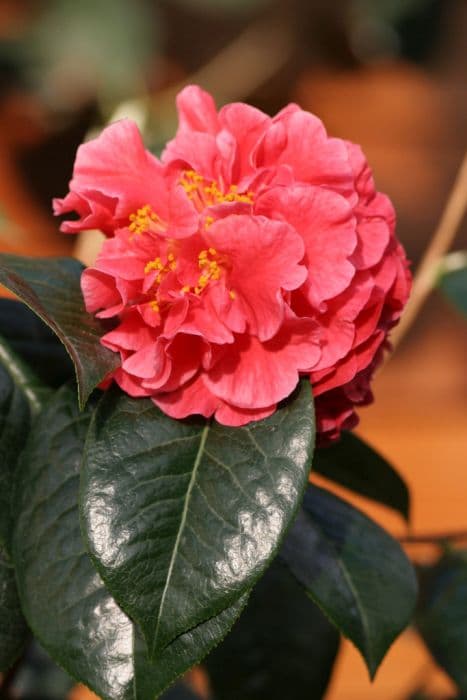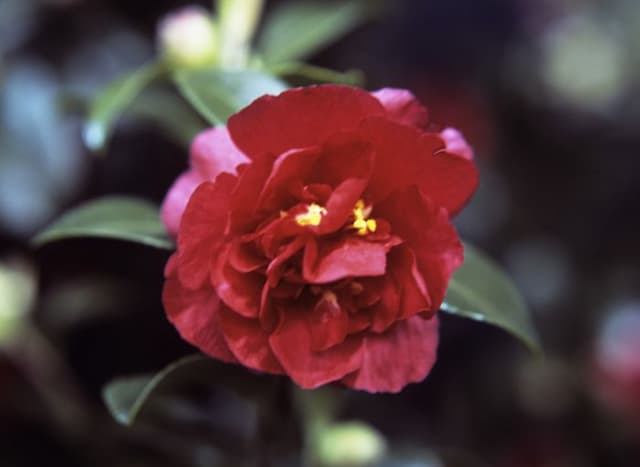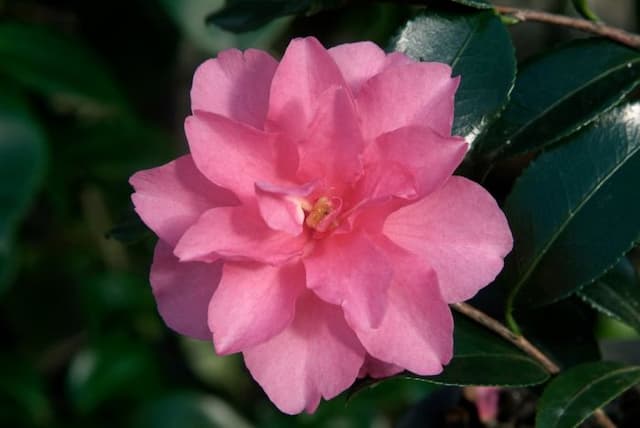Japanese Camellia Camellia japonica 'Margaret Davis'

ABOUT
Camellia japonica 'Margaret Davis' is a striking plant known for its beautiful and distinctive flowers. The blooms of 'Margaret Davis' are particularly noteworthy, featuring an elegant combination of colors. Each flower consists of creamy white petals that are edged with a vibrant pink margin, giving them a two-tone effect that is quite eye-catching. The petals are typically arranged in a formal, double pattern, with multiple layers that create a full and lush appearance. The flowers are complemented by glossy, dark green leaves that have an oval shape and a leathery texture, contributing to the plant's overall aesthetic appeal. The plant has a bushy, evergreen habit, making it a favorite among garden enthusiasts for its year-round interest.
About this plant
 Names
NamesFamily
Theaceae.
Synonyms
Japanese Camellia, Rose of Winter.
Common names
Camellia japonica 'Margaret Davis'.
 Toxicity
ToxicityTo humans
Camellia japonica, commonly known as the Japanese camellia, is not considered toxic to humans. There are no commonly reported symptoms of poisoning from ingesting parts of this plant, as it is generally recognized as non-toxic. Therefore, ingestion of Japanese camellia should not result in any adverse reactions or health consequences in humans.
To pets
The Japanese camellia is also not considered toxic to pets. It is typically regarded as safe around animals such as cats and dogs, and ingestion is unlikely to cause poisoning or adverse health effects. However, it's always prudent to keep an eye on pets and prevent them from eating large amounts of any non-food plants, as individual animals might have different sensitivities or reactions.
 Characteristics
CharacteristicsLife cycle
Perennials
Foliage type
Evergreen
Color of leaves
Dark green
Flower color
Pink
Height
6-12 feet (1.8-3.6 meters)
Spread
6-10 feet (1.8-3 meters)
Plant type
Shrub
Hardiness zones
7
Native area
Japan
Benefits
 General Benefits
General Benefits- Aesthetic Appeal: Camellia japonica 'Margaret Davis' features beautiful pink and white flowers that add visual interest to gardens.
- Extended Blooming Season: This variety often has a longer blooming period compared to other ornamental plants.
- Ease of Cultivation: It is relatively easy to cultivate in appropriate climate zones, making it a good choice for both novice and experienced gardeners.
- Durability: Camellias are known for their resilience and can live for many years with proper care.
- Versatility in Landscaping: Can be used in various garden designs, including formal, cottage, and woodland settings.
- Habitat Support: Provides food for pollinators when other sources are scarce, especially in late winter or early spring.
- Privacy and Screening: Can be used as a hedge or screen, providing privacy and reducing noise when planted in groups.
- Evergreen Foliage: The glossy green leaves of Camellia japonica 'Margaret Davis' offer year-round interest and texture in the landscape.
 Medical Properties
Medical PropertiesThis plant is not used for medical purposes.
 Air-purifying Qualities
Air-purifying QualitiesThis plant is not specifically known for air purifying qualities.
 Other Uses
Other Uses- Camellia japonica 'Margaret Davis' petals can be used to make natural dye for fabric and paper, providing a range of pink hues.
- The waxy leaves of the plant are ideal for creating glossy garnishes in culinary presentations, adding elegance to dishes.
- Fallen flowers of Camellia japonica 'Margaret Davis' can be scattered in ponds or water features for a decorative touch.
- Branches with buds and leaves can be used in ikebana, the Japanese art of flower arranging, for their structured beauty.
- Dried camellia petals can be used in crafting homemade soaps, giving them a gentle fragrance and exfoliating properties.
- The thick leaves can be used in small scale model making as natural foliage for trees and shrubs due to their sturdy structure.
- Camellia japonica 'Margaret Davis' can serve as a natural pest deterrent due to its fragrance, helping to protect nearby plants.
- Pressed camellia flowers can be used in scrapbooking or card making for their color and texture, adding a floral element to paper crafts.
- The flowers can be used to infuse oils, creating subtly scented oils for use in potpourri or homemade candles.
- The sturdy branches of Camellia japonica 'Margaret Davis' can be used as supports for climbing plants in the garden.
Interesting Facts
 Feng Shui
Feng ShuiCamellia is not used in Feng Shui practice.
 Zodiac Sign Compitability
Zodiac Sign CompitabilityCamellia is not used in astrology practice.
 Plant Symbolism
Plant Symbolism- Admiration - Camellia japonica 'Margaret Davis', or simply camellia, often symbolizes deep admiration for someone's beauty and talent, reflecting the striking appearance of the flower.
- Perfection - The camellia is associated with perfection due to its perfectly formed petals and lustrous leaves, representing the ideal beauty and excellence.
- Longevity and Faithfulness - Camellias are evergreen plants that live for many years, signifying enduring and steadfast qualities in relationships.
- Love - Different colors of camellias carry various meanings of love; the 'Margaret Davis' variety, with its white petals bordered by shades of pink, could combine the purity of white camellias with the longing for love represented by pink hues.
 Water
WaterFor the Japanese Camellia 'Margaret Davis', it is best to water thoroughly when the top inch or so of soil feels dry to the touch. Typically, this might mean watering once a week, but it can vary depending on weather conditions and the plant's environment. When watering, aim to provide enough water to moisten the soil all the way to the roots without leaving the plant standing in water. This could be approximately 1-2 gallons for a medium-sized shrub, but always adjust based on the plant's response and the soil's ability to retain moisture.
 Light
LightThe Japanese Camellia 'Margaret Davis' thrives in partially shaded conditions with morning sunlight and afternoon shade being ideal. An eastern exposure with protection from the harsh afternoon sun will help the flowers to last longer and prevent leaf scorch. Avoiding deep shade is also important as it can lead to sparse flowering and leggy growth.
 Temperature
TemperatureFor the Japanese Camellia 'Margaret Davis', ideal temperature conditions range from 60-70 degrees Fahrenheit, though they can survive brief periods outside of this range. They can generally handle minimum temperatures down to about 20 degrees Fahrenheit, but prolonged exposure to freezing temperatures can be damaging. Camellias prefer a consistently moderate climate without extreme variations in temperature.
 Pruning
PruningPrune the Japanese Camellia 'Margaret Davis' after flowering has finished, usually in the late winter or early spring. Pruning is primarily for shape and to remove any dead or weak wood. Thinning out the branches can help improve air circulation and sunlight penetration for better health and more robust flowering. Pruning every year is not necessary; do so every 2-3 years, or as needed to maintain the desired shape.
 Cleaning
CleaningAs needed
 Soil
SoilJapanese Camellia 'Margaret Davis' thrives in well-draining, slightly acidic soil with a pH of 5.5-6.5. A mix of 1/3 pine bark, 1/3 garden soil, and 1/3 peat moss has proven effective.
 Repotting
RepottingJapanese Camellia 'Margaret Davis' should be repotted every 2-3 years during late winter or early spring, before the onset of new growth.
 Humidity & Misting
Humidity & MistingJapanese Camellia 'Margaret Davis' prefers high humidity levels, ideally between 50-60%, to thrive and produce its characteristic blooms.
 Suitable locations
Suitable locationsIndoor
Place in bright, indirect light; ensure high humidity.
Outdoor
Plant in partial shade; protect from afternoon sun.
Hardiness zone
7-9 USDA
 Life cycle
Life cycleCamellia japonica 'Margaret Davis', commonly known as Japanese camellia, begins its life as a seed, which after germination grows into a small seedling with a typical dicotyledonous pair of starter leaves. The seedling develops into a young plant with a main root and foliage that continues to mature into a bushy shrub. During its juvenile phase, it focuses on vegetative growth, establishing a strong root system and branching structure. After several years, when mature enough, it starts its reproductive phase, producing buds that bloom into large, ornate, white flowers with pink edges and yellow stamens in late winter to spring. Following pollination, fertilized flowers develop seed pods that ripen and eventually release seeds, completing the cycle. The Japanese camellia is an evergreen, and under favourable conditions, it can live for many decades, continuously growing and going through repeated annual cycles of flowering and seed production.
 Propogation
PropogationPropogation time
Spring-Early Summer
The Camellia japonica 'Margaret Davis', commonly known as the Japanese camellia, is most effectively propagated using semi-hardwood cuttings. This method involves taking cuttings from the new growth that has started to mature but is not yet completely hardwood. Typically, the ideal time for taking these cuttings is in late summer or early fall. After cutting, the bottom end of the cutting should be dipped in rooting hormone to encourage root development. The prepared cutting is then planted in a well-draining potting mix and covered with a plastic bag or placed in a greenhouse to maintain high humidity around the foliage. The cutting needs to be kept in a warm, indirect light until roots have formed, which usually takes several weeks to a few months. It is important to keep the soil consistently moist but not waterlogged during this time.









